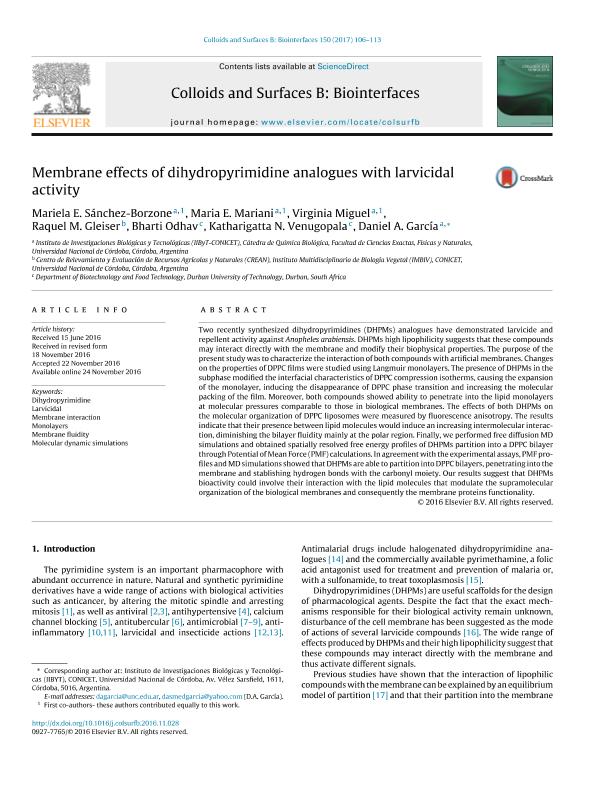Artículo
Membrane effects of dihydropyrimidine analogues with larvicidal activity
Sánchez, Mariela Eugenia ; Mariani, Maria Elisa
; Mariani, Maria Elisa ; Miguel, Virginia
; Miguel, Virginia ; Gleiser, Raquel M.
; Gleiser, Raquel M. ; Odhav, Bharti; Venugopala, Katharigatta N.; Garcia, Daniel Asmed
; Odhav, Bharti; Venugopala, Katharigatta N.; Garcia, Daniel Asmed
 ; Mariani, Maria Elisa
; Mariani, Maria Elisa ; Miguel, Virginia
; Miguel, Virginia ; Gleiser, Raquel M.
; Gleiser, Raquel M. ; Odhav, Bharti; Venugopala, Katharigatta N.; Garcia, Daniel Asmed
; Odhav, Bharti; Venugopala, Katharigatta N.; Garcia, Daniel Asmed
Fecha de publicación:
01/02/2017
Editorial:
Elsevier Science
Revista:
Colloids and Surfaces B: Biointerfaces
ISSN:
0927-7765
Idioma:
Inglés
Tipo de recurso:
Artículo publicado
Clasificación temática:
Resumen
Two recently synthesized dihydropyrimidines (DHPMs) analogues have demonstrated larvicide and repellent activity against Anopheles arabiensis. DHPMs high lipophilicity suggests that these compounds may interact directly with the membrane and modify their biophysical properties. The purpose of the present study was to characterize the interaction of both compounds with artificial membranes. Changes on the properties of DPPC films were studied using Langmuir monolayers. The presence of DHPMs in the subphase modified the interfacial characteristics of DPPC compression isotherms, causing the expansion of the monolayer, inducing the disappearance of DPPC phase transition and increasing the molecular packing of the film. Moreover, both compounds showed ability to penetrate into the lipid monolayers at molecular pressures comparable to those in biological membranes. The effects of both DHPMs on the molecular organization of DPPC liposomes were measured by fluorescence anisotropy. The results indicate that their presence between lipid molecules would induce an increasing intermolecular interaction, diminishing the bilayer fluidity mainly at the polar region. Finally, we performed free diffusion MD simulations and obtained spatially resolved free energy profiles of DHPMs partition into a DPPC bilayer through Potential of Mean Force (PMF) calculations. In agreement with the experimental assays, PMF profiles and MD simulations showed that DHPMs are able to partition into DPPC bilayers, penetrating into the membrane and stablishing hydrogen bonds with the carbonyl moiety. Our results suggest that DHPMs bioactivity could involve their interaction with the lipid molecules that modulate the supramolecular organization of the biological membranes and consequently the membrane proteins functionality.
Archivos asociados
Licencia
Identificadores
Colecciones
Articulos(CCT - CORDOBA)
Articulos de CTRO.CIENTIFICO TECNOL.CONICET - CORDOBA
Articulos de CTRO.CIENTIFICO TECNOL.CONICET - CORDOBA
Articulos(IIBYT)
Articulos de INSTITUTO DE INVESTIGACIONES BIOLOGICAS Y TECNOLOGICAS
Articulos de INSTITUTO DE INVESTIGACIONES BIOLOGICAS Y TECNOLOGICAS
Articulos(IMBIV)
Articulos de INST.MULTIDISCIPL.DE BIOLOGIA VEGETAL (P)
Articulos de INST.MULTIDISCIPL.DE BIOLOGIA VEGETAL (P)
Citación
Sánchez, Mariela Eugenia; Mariani, Maria Elisa; Miguel, Virginia; Gleiser, Raquel M.; Odhav, Bharti; et al.; Membrane effects of dihydropyrimidine analogues with larvicidal activity; Elsevier Science; Colloids and Surfaces B: Biointerfaces; 150; 1-2-2017; 106-113
Compartir
Altmétricas



